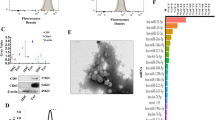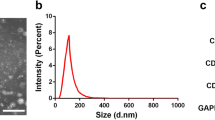Abstract
Background Transplantation of extracellular vesicles (EVs) from stem cells is a feasible scheme for traumatic spinal cord injury (SCI). However, there is no relevant report about stem cells derived EVs loaded with curcumin for SCI treatment. Methods Mouse umbilical cord mesenchymal stem cells (MUMSCs) were incubated in the medium containing curcumin (20 µM) for 48 h. Extracellular vesicles (EVs) and curcumin-primed EVs (Cur-EVs) were collected by ultracentrifugation. Characterizations of EVs/Cur-EVs were analyzed by western blotting with CD9 and CD81 antibodies, transmission electron microscopy and nano-tracking analysis. Curcumin in the Cur-EVs was analyzed by high performance liquid phase chromatography at 430 nm wavelength. Immunofluorescence and in vivo imaging methods were used to confirm biocompatibility of EVs/Cur-EVs in vitro and in vivo. Mice with complete SCI were treated with EVs/Cur-EVs to compare the differences of locomotor function, inflammation, histological changes and remyelination. Results The isolated EVs and Cur-EVs from MUMSCs have good biocompatibility. Compared with the model mice, the locomotor function, inflammation and axonal regeneration of mice were significantly improved after injection of Cur-EVs/EVs. Furthermore, it is more effective for structural and functional recovery of complete SCI after the Cur-EVs treatment compared with the EVs treatment. In the lesioned regions, the macrophage polarization from M1 to M2 phenotype and axonal regeneration were significantly improved in the Cur-EVs group compared with the EVs group. Conclusions Our data suggested that EVs from MUMSCs might be a promising drug delivery vehicle of curcumin for the efficient and biocompatible treatment of severe SCI.







Similar content being viewed by others
References
Zhang B, Lin F, Dong J, Liu J, Ding Z, Xu J (2021) Peripheral macrophage-derived Exosomes promote repair after spinal cord Injury by inducing local anti-inflammatory type Microglial polarization via increasing Autophagy. Int J Biol Sci 17(5):1339–1352. https://doi.org/10.7150/ijbs.54302
Zhou W, Silva M, Feng C, Zhao S, Liu L, Li S, Zhong J, Zheng W (2021) Exosomes derived from human placental mesenchymal stem cells enhanced the recovery of spinal cord injury by activating endogenous neurogenesis. Stem Cell Res Ther 12(1):174. https://doi.org/10.1186/s13287-021-02248-2
Lee YS, Cho DC, Kim CH, Han I, Gil EY, Kim KT (2019) Effect of curcumin on the inflammatory reaction and functional recovery after spinal cord injury in a hyperglycemic rat model. Spine J 19(12):2025–2039. https://doi.org/10.1016/j.spinee.2019.07.013
Wang C, Wang M, Xia K, Wang J, Cheng F, Shi K, Ying L, Yu C, Xu H, Xiao S, Liang C, Li F, Lei B, Chen Q (2021) A bioactive injectable self-healing anti-inflammatory hydrogel with ultralong extracellular vesicles release synergistically enhances motor functional recovery of spinal cord injury. Bioact Mater 6(8):2523–2534. https://doi.org/10.1016/j.bioactmat.2021.01.029
Fan B, Wei Z, Yao X, Shi G, Cheng X, Zhou X, Zhou H, Ning G, Kong X, Feng S (2018) Microenvironment Imbalance of spinal cord Injury. Cell Transpl 27(6):853–866. https://doi.org/10.1177/0963689718755778
Li L, Zhang Y, Mu J, Chen J, Zhang C, Cao H, Gao J (2020) Transplantation of human mesenchymal stem-cell-derived Exosomes immobilized in an Adhesive Hydrogel for Effective Treatment of spinal cord Injury. Nano Lett 20(6):4298–4305. https://doi.org/10.1021/acs.nanolett.0c00929
Yang B, Zhang F, Cheng F, Ying L, Wang C, Shi K, Wang J, Xia K, Gong Z, Huang X, Yu C, Li F, Liang C, Chen Q (2020) Strategies and prospects of effective neural circuits reconstruction after spinal cord injury. Cell Death Dis 11(6):439. https://doi.org/10.1038/s41419-020-2620-z
Guo S, Perets N, Betzer O, Ben-Shaul S, Sheinin A, Michaelevski I, Popovtzer R, Offen D, Levenberg S (2019) Intranasal delivery of mesenchymal stem cell derived Exosomes loaded with phosphatase and tensin homolog siRNA repairs complete spinal cord Injury. ACS Nano 13(9):10015–10028. https://doi.org/10.1021/acsnano.9b01892
Hu X, Zhou X, Li Y, Jin Q, Tang W, Chen Q, Aili D, Qian H (2019) Application of stem cells and chitosan in the repair of spinal cord injury. Int J Dev Neurosci 76:80–85. https://doi.org/10.1016/j.ijdevneu.2019.07.005
Gazdic M, Volarevic V, Harrell CR, Fellabaum C, Jovicic N, Arsenijevic N, Stojkovic M (2018) Stem cells therapy for spinal cord Injury. Int J Mol Sci 19(4). https://doi.org/10.3390/ijms19041039
Liu WZ, Ma ZJ, Li JR, Kang XW (2021) Mesenchymal stem cell-derived exosomes: therapeutic opportunities and challenges for spinal cord injury. Stem Cell Res Ther 12(1):102. https://doi.org/10.1186/s13287-021-02153-8
Papa S, Pizzetti F, Perale G, Veglianese P, Rossi F (2020) Regenerative medicine for spinal cord injury: focus on stem cells and biomaterials. Expert Opin Biol Ther 20(10):1203–1213. https://doi.org/10.1080/14712598.2020.1770725
Marzan AL, Nedeva C, Mathivanan S (2021) Extracellular vesicles in metabolism and metabolic Diseases. Subcell Biochem 97:393–410. https://doi.org/10.1007/978-3-030-67171-6_15
Zhong D, Cao Y, Li CJ, Li M, Rong ZJ, Jiang L, Guo Z, Lu HB, Hu JZ (2020) Neural stem cell-derived exosomes facilitate spinal cord functional recovery after injury by promoting angiogenesis. Exp Biol Med (Maywood) 245(1):54–65. https://doi.org/10.1177/1535370219895491
Blandin A, Le Lay S (2021) [Extracellular vesicles and metabolic diseases: dangerous liaisons]. Med Sci (Paris) 37(12):1125–1132. https://doi.org/10.1051/medsci/2021209
Ren Z, Qi Y, Sun S, Tao Y, Shi R (2020) Mesenchymal stem cell-derived Exosomes: hope for spinal cord Injury Repair. Stem Cells Dev 29(23):1467–1478. https://doi.org/10.1089/scd.2020.0133
He R, Jiang Y, Shi Y, Liang J, Zhao L (2020) Curcumin-laden exosomes target ischemic brain tissue and alleviate cerebral ischemia-reperfusion injury by inhibiting ROS-mediated mitochondrial apoptosis. Mater Sci Eng C Mater Biol Appl 117:111314. https://doi.org/10.1016/j.msec.2020.111314
Fan Y, Chen Z, Zhang M (2022) Role of exosomes in the pathogenesis, diagnosis, and treatment of central nervous system diseases. J Transl Med 20(1):291. https://doi.org/10.1186/s12967-022-03493-6
Liang Y, Duan L, Lu J, Xia J (2021) Engineering exosomes for targeted drug delivery. Theranostics 11(7):3183–3195. https://doi.org/10.7150/thno.52570
Oskouie MN, Aghili Moghaddam NS, Butler AE, Zamani P, Sahebkar A (2019) Therapeutic use of curcumin-encapsulated and curcumin-primed exosomes. J Cell Physiol 234(6):8182–8191. https://doi.org/10.1002/jcp.27615
Mobahat M, Sadroddiny E, Nooshabadi VT, Ebrahimi-Barough S, Goodarzi A, Malekshahi ZV, Ai J (2022) Curcumin-loaded human endometrial stem cells derived exosomes as an effective carrier to suppress alpha-synuclein aggregates in 6OHDA-induced Parkinson’s disease mouse model. Cell Tissue Bank. https://doi.org/10.1007/s10561-022-10008-6
Banikazemi Z, Haji HA, Mohammadi M, Taheripak G, Iranifar E, Poursadeghiyan M, Moridikia A, Rashidi B, Taghizadeh M, Mirzaei H (2018) Diet and cancer prevention: dietary compounds, dietary MicroRNAs, and dietary exosomes. J Cell Biochem 119(1):185–196. https://doi.org/10.1002/jcb.26244
Mohi-Ud-Din R, Mir RH, Wani TU, Shah AJ, Mohi-Ud-Din I, Dar MA, Pottoo FH (2022) Novel Drug Delivery System for Curcumin: implementation to Improve Therapeutic Efficacy against Neurological Disorders. Comb Chem High Throughput Screen 25(4):607–615. https://doi.org/10.2174/1386207324666210705114058
Kalani A, Chaturvedi P, Kamat PK, Maldonado C, Bauer P, Joshua IG, Tyagi SC, Tyagi N (2016) Curcumin-loaded embryonic stem cell exosomes restored neurovascular unit following ischemia-reperfusion injury. Int J Biochem Cell Biol 79:360–369. https://doi.org/10.1016/j.biocel.2016.09.002
Li S, Stöckl S, Lukas C, Herrmann M, Brochhausen C, König MA, Johnstone B, Grässel S (2021) Curcumin-primed human BMSC-derived extracellular vesicles reverse IL-1β-induced catabolic responses of OA chondrocytes by upregulating miR-126-3p. Stem Cell Res Ther 12(1):252. https://doi.org/10.1186/s13287-021-02317-6
Bonilla P, Hernandez J, Giraldo E, González-Pérez MA, Alastrue-Agudo A, Elkhenany H, Vicent MJ, Navarro X, Edel M, Moreno-Manzano V (2021) Human-Induced neural and mesenchymal stem cell therapy combined with a Curcumin Nanoconjugate as a spinal cord Injury Treatment. Int J Mol Sci 22(11). https://doi.org/10.3390/ijms22115966
Basso DM, Beattie MS, Bresnahan JC (1995) A sensitive and reliable locomotor rating scale for open field testing in rats. J Neurotrauma 12(1):1–21. https://doi.org/10.1089/neu.1995.12.1
Spejo AB, Chiarotto GB, Ferreira ADF, Gomes DA, Ferreira RS Jr, Barraviera B, Oliveira ALR (2018) Neuroprotection and immunomodulation following intraspinal axotomy of motoneurons by treatment with adult mesenchymal stem cells. J Neuroinflammation 15(1):230. https://doi.org/10.1186/s12974-018-1268-4
Moszczynski AJ, Volkening K, Strong MJ (2020) Neurofilament immunohistochemistry followed by Luxol fast Blue, for staining axons and myelin in the same paraffin section of spinal cord. Appl Immunohistochem Mol Morphol 28(7):562–565. https://doi.org/10.1097/pai.0000000000000814
Charnay Y, Paulin C, Dray F, Dubois PM (1984) Distribution of enkephalin in human fetus and infant spinal cord: an immunofluorescence study. J Comp Neurol 223(3):415–423. https://doi.org/10.1002/cne.902230307
Ahn M, Kim H, Kim JT, Lee J, Hyun JW, Park JW, Shin T (2006) Gamma-ray irradiation stimulates the expression of caveolin-1 and GFAP in rat spinal cord: a study of immunoblot and immunohistochemistry. J Vet Sci 7(4):309–314. https://doi.org/10.4142/jvs.2006.7.4.309
Song Y, Li S, Song B, Zhang Y, Gao W, Li N, Fan K, Ma J (2014) The pathological changes in the spinal cord after dural tear with and without autologous fascia repair. Eur Spine J 23(7):1531–1540. https://doi.org/10.1007/s00586-014-3326-7
Xiang D, Li Y, Cao Y, Huang Y, Zhou L, Lin X, Qiao Y, Li X, Liao D (2021) Different Effects of endothelial extracellular vesicles and LPS-Induced endothelial extracellular vesicles on vascular smooth muscle cells: role of Curcumin and its derivatives. Front Cardiovasc Med 8:649352. https://doi.org/10.3389/fcvm.2021.649352
Aqil F, Munagala R, Jeyabalan J, Agrawal AK, Gupta R (2017) Exosomes for the enhanced tissue bioavailability and efficacy of Curcumin. Aaps j 19(6):1691–1702. https://doi.org/10.1208/s12248-017-0154-9
Vashisht M, Rani P, Sunita, Onteru SK, Singh D (2018) Curcumin primed exosomes reverses LPS-induced pro-inflammatory gene expression in buffalo granulosa cells. J Cell Biochem 119(2):1488–1500. https://doi.org/10.1002/jcb.26309
Liu W, Rong Y, Wang J, Zhou Z, Ge X, Ji C, Jiang D, Gong F, Li L, Chen J, Zhao S, Kong F, Gu C, Fan J, Cai W (2020) Exosome-shuttled miR-216a-5p from hypoxic preconditioned mesenchymal stem cells repair traumatic spinal cord injury by shifting microglial M1/M2 polarization. J Neuroinflammation 17(1):47. https://doi.org/10.1186/s12974-020-1726-7
Yuan J, Botchway BOA, Zhang Y, Tan X, Wang X, Liu X (2019) Curcumin can improve spinal cord Injury by inhibiting TGF-β-SOX9 signaling pathway. Cell Mol Neurobiol 39(5):569–575. https://doi.org/10.1007/s10571-019-00671-x
Sanivarapu R, Vallabhaneni V, Verma V (2016) The Potential of Curcumin in Treatment of Spinal Cord Injury. Neurol Res Int. 2016: 9468193. https://doi.org/10.1155/2016/9468193
Sun D, Zhuang X, Xiang X, Liu Y, Zhang S, Liu C, Barnes S, Grizzle W, Miller D, Zhang HG (2010) A novel nanoparticle drug delivery system: the anti-inflammatory activity of curcumin is enhanced when encapsulated in exosomes. Mol Ther 18(9):1606–1614. https://doi.org/10.1038/mt.2010.105
Gao ZS, Zhang CJ, Xia N, Tian H, Li DY, Lin JQ, Mei XF, Wu C (2021) Berberine-loaded M2 macrophage-derived exosomes for spinal cord injury therapy. Acta Biomater 126:211–223. https://doi.org/10.1016/j.actbio.2021.03.018
Sun G, Li G, Li D, Huang W, Zhang R, Zhang H, Duan Y, Wang B (2018) hucMSC derived exosomes promote functional recovery in spinal cord injury mice via attenuating inflammation. Mater Sci Eng C Mater Biol Appl 89:194–204. https://doi.org/10.1016/j.msec.2018.04.006
He B, Nan G (2016) Neuronal regeneration after acute spinal cord injury in adult rats. Spine J 16(12):1459–1467. https://doi.org/10.1016/j.spinee.2016.06.020
Funding
This work was supported by the Natural Science Foundation of China (Project No. 81871781) and the Key Project of Natural Science Foundation of Heilongjiang Province of China (Project No. ZD2021H003).
Author information
Authors and Affiliations
Contributions
All authors contributed to the study conception and design. Material preparation, data collection and analysis were performed by Haiqing Tian, Zhigang Li and Zhibin Peng. The first draft of the manuscript was written by Wei Xiong. All authors commented on previous versions of the manuscript. All authors read and approved the final manuscript.
Corresponding author
Ethics declarations
Competing Interests
The authors have no relevant financial or non-financial to disclose.
Ethics Approval
This study was performed in line with the principles of the Guide for the Care and Use of Laboratory Animals (National Institutes of Health, eighth edition, 2011). Approval was granted by the First Affiliated Hospital of Harbin Medical University (Approval No. 202103028-018).
Additional information
Publisher’s Note
Springer Nature remains neutral with regard to jurisdictional claims in published maps and institutional affiliations.
Rights and permissions
Springer Nature or its licensor (e.g. a society or other partner) holds exclusive rights to this article under a publishing agreement with the author(s) or other rightsholder(s); author self-archiving of the accepted manuscript version of this article is solely governed by the terms of such publishing agreement and applicable law.
About this article
Cite this article
Xiong, W., Tian, H., Li, Z. et al. Curcumin-Primed Umbilical Cord Mesenchymal Stem Cells-Derived Extracellular Vesicles Improve Motor Functional Recovery of Mice with Complete Spinal Cord Injury by Reducing Inflammation and Enhancing Axonal Regeneration. Neurochem Res 48, 1334–1346 (2023). https://doi.org/10.1007/s11064-022-03832-5
Received:
Revised:
Accepted:
Published:
Issue Date:
DOI: https://doi.org/10.1007/s11064-022-03832-5




